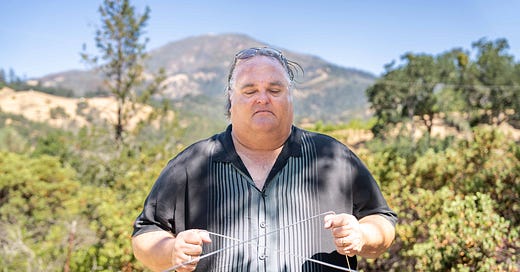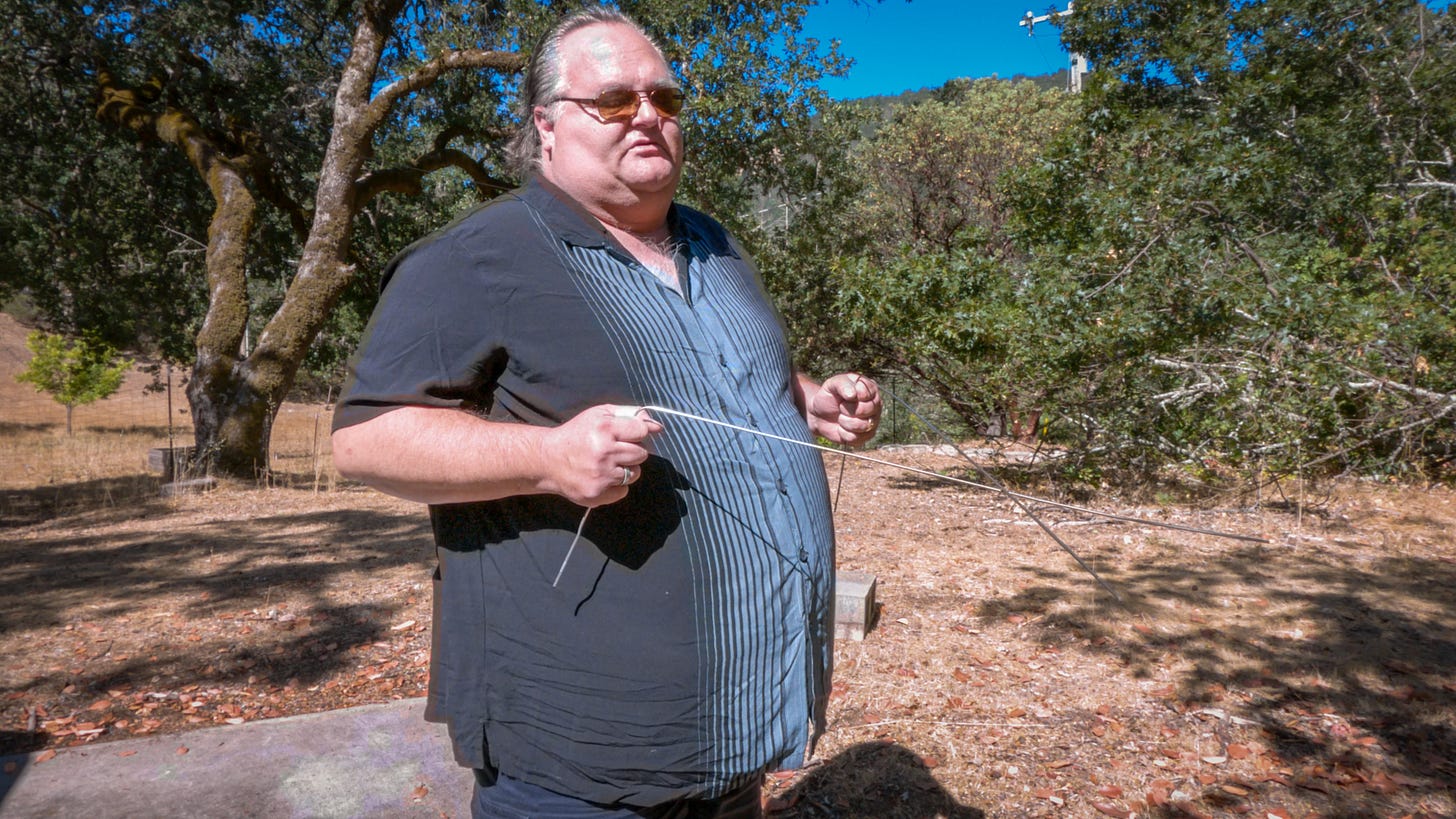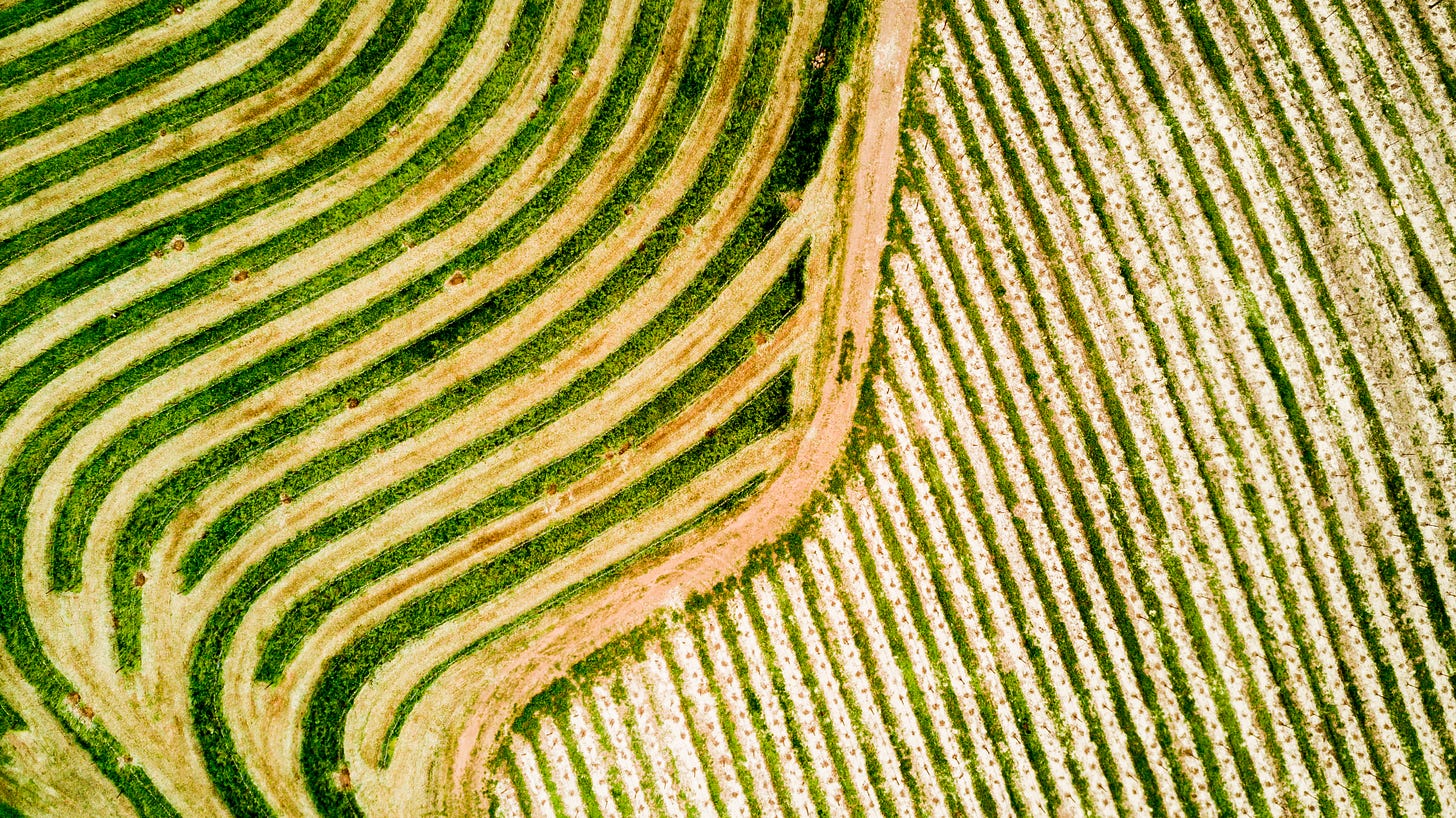NAPA VALLEY, Calif. — In a striking departure from the parched conditions of the past decade, 2023 has offered a much-needed reprieve to the drought-weary Napa Valley. However, this unexpected change in weather patterns has had an unforeseen impact on Rob Thompson, a renowned dowser known for his uncanny ability to locate hidden water sources using nothing more than a pair of stainless-steel rods. As the drought takes a temporary backseat, Thompson's once-frenetic business has experienced a noticeable slowdown.
"It's been nothing short of a blessing,” Thompson said. “For years we hardly had a moment's respite, working six days a week. The recent rains have certainly played a part in it, but the slowing economy also contributes to the lull. Nevertheless, the demand is still good, and with the weather warming up, our phone rings more often now."
During the harsh years of drought, Thompson's services were sought after by desperate landowners, ranchers and vineyard managers grappling with severe water scarcity.
Video of Rob Thompson explaining how he goes about the ancient art of water dowsing - Tim Carl Video
Ancient roots
Water-witching, dowsing or doodlebugging is a mystical technique with ancient roots that involves the use of divining rods (often willow sticks) to locate groundwater sources. While its origins can be traced back to ancient times, it gained popularity in Europe during the Middle Ages. Its mystical and magical aura led to the use of terms such as "water witch" or "warlock,” possibly stemming from the witch-trial atmosphere of the 17th century.
Thompson claims that his abilities extend beyond water-finding, asserting that he can locate myriad objects underground or even underwater.
"From water to oil and gas, minerals like gold and silver, and even shipwrecks — I can find it all,” he said.
Adding to the intrigue, Thompson claims he can locate these objects remotely, even thousands of miles away, using a pendant that will circle the target location on a map when he enters an open state of mind.
As with any mystical endeavor, skeptics abound, and science-oriented professionals, including hydrogeologists, dismiss water-witching as "totally without scientific merit," according to the National Ground Water Association.
And although scientific studies show little or no evidence that dowsing works, Thompson suggests that such studies often test buried barrels of water or pipes, which is not at all like natural water flowing through the earth, so such studies need to be taken with a grain of salt.
A gusher
At the age of 10 in 1978, Thompson's journey with dowsing began when he used two willow sticks to locate a “gusher of a well.” The knowledge of this ancient art was handed down to him by his Uncle Wayne, who had been taught by Thompson's grandfather, Walter Thompson. Walter had acquired the Weeks Drilling & Pump Co. during the 1940s.
Throughout the years Thompson has explored various career paths, including working at Weeks and running his own construction company. No matter where life has led him, however, he has always been drawn back to dowsing.
“First, I just really enjoy helping people find things,” he said, “but second, it’s something that I’ve always been good at. There’s this moment when you meet someone and they are completely skeptical, but then, after you’ve found what they are looking for, they’re like, ‘I don’t know how you do it, but I am so glad that you do it.’”
A skeptic
As a trained scientist with a Ph.D. in the natural sciences, I find the evidence about water-witching less than satisfactory. That said, in the early 2000s, when I was managing a vineyard in Knights Valley, I turned to the mystical arts after we’d drilled two dry wells. The experience resulted in finding a well that had ample water but also caused me to question the very nature of our connection with the environment.
One of the region's best-known dowsers, Laurie Wood, came to the property. We walked to one of the highest peaks on the site, at which time he brought out metal rods that had been bent L-shaped. Gripping the shorter sides and thrusting them outward, he began scanning the horizon. Suddenly the rods crossed X-like.
Wood turned to me and smiled.
“That way,” he said, pointing in the direction of where the rods had crossed. “It’s a big one. About 200 yards over there.”
Once at the location, he brought out his rods again. Immediately they formed the X, and then he began walking in circles and mumbling to himself.
At the time I thought that he might be casting a spell, and the experience only added to my growing sense that I was just another sucker who was being tricked out of about $800. (Today the cost can run twice that or more.)
“It’s about 30 gallons a minute (which is fantastic, with a well producing 10 gpm being considered respectable in these parts), and it is about 320 feet below the surface,” he said confidently.
I shook my head and resolved to consider the entire endeavor a costly show that I might one day tell my children about. I mean, we’d just spent thousands to drill unproductive wells and had used hydrologists and satellite data to assist in the search. And here was an old man with what looked like straightened coat hangers walking about chanting into the ether, making bold proclamations about not only that water existed hundreds of feet under the earth but also just how deep it was and how productive the well would be. Come on!
The man grinned even wider.
“Here, you want to try it?” he asked, handing me the rods. “Not everybody has the touch.”
I did want to see how this fraud was tricking me out of my hard-earned cash. I grabbed the rods and gripped them in my hands, holding them tight to ensure that the ideomotor effect (a psychological phenomenon where a person’s subconscious mind can cause the body to move in ways that they’re not consciously aware of) did not become a factor. And I brought to mind all the various psychological effects that might be in play — the random reinforcement effect, superstition, confirmation bias or magical thinking — all of which might cause me to skew the results.
As I was pondering all this, I took a few steps forward and the rods crossed. I stepped back, and the rods uncrossed. I did it again with the same results before handing them back to the man.
Three weeks later, we had a well drilled to a depth of 340 feet that was sending 35 gpm skyward to help supply water to a home, a large vegetable garden, a natural pond full of wildlife and a small vineyard.
I came to find out that Wood had been one of the leading innovators in viticultural practices, introducing solid-set sprinkler systems for frost protection and aerial mapping of vineyards. He’d also donated a portion of his client fees to the Wood Family Memorial Scholarship Fund that supported underfunded students seeking a college degree at my alma mater, St. Helena High School.
The rise of water-witching enthusiasts isn't confined to Wood and Thompson alone. Notable figures such as Marc Mondavi, co-owner of Charles Krug Winery, and Jean-Charles Boisset, owner of many wineries including Buena Vista Winery, have embraced the practice to find precious water sources for their vineyards.
Thompson thinks that the water under the earth (or whatever other object he is seeking) creates a disruption in the earth’s magnetic field that affects the rods, but he, too, is unsure exactly how it might work from a scientific standpoint, especially when it comes to finding water on a paper map.
“This world is a mysterious place,” he said and then shrugged. “There are lots of things we do every day but can't explain exactly how it works.”
Water in California is like oil in Texas
In California, where farming and agriculture account for a large percentage of the GDP, water has always been a valuable and contentious commodity, somewhat akin to oil in Texas. And as Benjamin Franklin famously said, “When the well is dry, we know the value of water.”
For those seeking sources of water in California, dowsing is just another reality. And like any water-related issues in the Golden State, there are those who see people seeking to drill more wells as potential threats to the long-term health of the environment, reducing groundwater stores and eventually impacting waterways — creeks and rivers.
According to the California Department of Water Resources, there are as many as 2 million water wells tapping California’s groundwater, with approximately 7,000 to 15,000 new wells constructed each year. Groundwater supplies approximately 40% of California's total water supply in average years and in some regions of the state up to 60% in dry years.
According to the Napa County Public Works Groundwater Sustainability Program, “Nearly half of all water used in Napa County comes from below the Napa Valley floor, where layers of sand and gravel provide a natural reservoir for water in underground aquifers.”
As the state faced severe water shortages, many communities and individuals turned to well-drilling as a means to access groundwater and secure a reliable water supply. While well-drilling has provided a lifeline during normal years and even more so during droughts, it has also raised concerns about the sustainability of groundwater resources. Excessive well-drilling can lead to overextraction, depleting aquifers and causing land subsidence, which can permanently reduce the underground storage capacity. Moreover, unregulated well-drilling practices can result in conflicts over water rights and potential contamination of groundwater sources, further exacerbating the challenges in managing California's water resources.
In response to these issues, California has been implementing stricter regulations on well-drilling and groundwater management to ensure a more sustainable approach. Monitoring and managing groundwater extraction are essential to prevent long-term damage to aquifers and maintain a reliable water supply for the state's growing population and agricultural needs.
As per the June 2023 report by the Napa County Grand Jury, Napa County has been categorized as a "medium priority" water region (basin) under the regulations of the Sustainable Groundwater Management Act. Within this region, 72% of the water is utilized for agricultural purposes, while 15% is allocated for industrial/landscape use and 13% for residential consumption. This designation obligates the county to establish a Groundwater Sustainability Agency and formulate a comprehensive Groundwater Sustainability Plan to prevent undesirable consequences and manage excessive water depletion within the next two decades. To fulfill this requirement, the board of supervisors has taken on the role of the designated GSA.
It is unclear if water-dowsing will be addressed in any Napa Valley-specific GSP.
The future
The demand for water-witching services is influenced by various dynamic factors. The recent slowdown in activity may be a result of the temporary relief from drought, but as the region’s cyclic weather patterns return to water scarcity, demand for these services could surge once again. California's more proactive approach to regulate and monitor well construction may also play a role in shaping the future of water-witching demand. Amidst these ongoing changes, the enduring value of water-dowsing and its potential integration with modern practices and sustainability efforts may one day redefine how those in the Napa Valley locate, manage and protect their precious water resources.
Tim Carl is a Napa Valley based photojournalist.










My grandfather tried to teach me. I didn't listen. Fascinating.
Tim, I loved reading your experience dowsing with Laurie Wood! We had similar success with him back in the early 90s on the east side of the Valley. Laurie patiently let both me and my ex give it a try and lo and behold, we both had some success, tho my ex's was stronger. But when Laurie simply covered my dowsing hand with one of his--zing! Defies understanding.